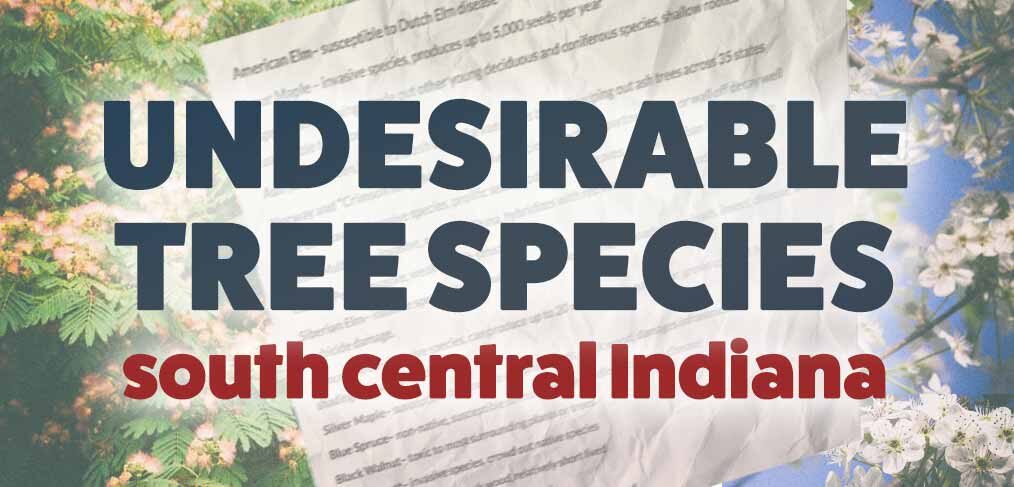
Undesirable Species of Trees to Plant in Indiana
Choosing a species of tree to plant is a daunting task. There are a number of variables to consider.
If you haven’t done so already, please check out our blog entitled Tree Selection For Your Home. This will help in your quest of finding the right species of tree to plant at your specific site.
Here is our list of trees we have deemed undesirable to plant in south central Indiana
American Elm– susceptible to Dutch Elm disease
Amur Maple – invasive species, produces up to 5,000 seeds per year
Aspen– fast growing, shade out other young deciduous and coniferous species, shallow rooted which is susceptible to uprooting
Ash (white, green,)- emerald ash borer (larvae of this beetle is wiping out ash trees across 35 states
Norway and “Crimson King” Maple– invasive species, do not compartmentalize or wall off decay well
Tree of Heaven– invasive species, prolific seed producer, toxic leaves, damages urban infrastructure
White Mulberry– invasive, native to China, hybridizes with red mulberry which is endangering it
Callery Pear– invasive, weak branch structure
Siberian Elm– invasive species, fast growing, susceptible to wind, ice loads, snow loads, insect, disease, and herbicide damage.
Princess Tree– invasive species, can produce up to 20 million seeds each year, grows up to 15 feet per year and shading out native species
Silver Maple– susceptible to wind, ice and snow loads, weak wood, damages infrastructure
Blue Spruce– non-native, susceptible to rhizosphaera needlecast (fungal disease)
Black Walnut– toxic to most surrounding plants or trees
Black Locust– invasive species, crowd out native species
Boxelder– fast growing, weak wood, relatively short lived
Lombardy Poplar– fast growing, weak wood
Mimosa– invasive susceptible to pest and diseases, weak wood
Additional Considerations:
We also see a LOT of homeowners that don’t consider the tree’s size at full maturity when planting. We often see homeowners choose a tree that provides the proper function and has the proper form, but then don’t consider the site conditions. We even see homeowners take the proper steps of function, form, size and site conditions, but don’t consider the species characteristics.
For example
Silver Maples have been a staple in many towns for many years because of their quick shade and rapid growth. After World War II, homeowners were planting silver maples near their homes. They were looking for that quick shade to help cool their homes. Fast forward 50 to 70 years and silver maples are wreaking havoc on homeowners and communities. Their roots are conflicting with sidewalks and driveways. Their trunks are susceptible to decay and their branches are HIGHLY susceptible to wind, ice and snow loads. The homeowners in the mid 1900s did consider the function and form, but not the size and definitely not the species characteristics. These trees, on average, can grow up to 60-80 feet tall and 30-50 feet wide and sometimes ever larger. The opportunistic people who planted these trees had good intentions, but today we are removing more silver maples than any other species.
Bradford Pear trees are another species that have been widely planted since the 1960s. They were planted across the United States because of their ability to flourish in poor soil whether it was wet or dry, acidic or alkaline. They were a symbol of America’s postwar suburban expansion that embodied the idea of opportunity and peace. People fell in love with its upright form, perfect symmetry, explosion of white flowers and their glossy green leaves that turned a resilient reddish orange in the fall. Well, the honeymoon phase is now over. The Bradford Pear is now showing its true colors for everyone to see and it’s species characteristics is the culprit to blame. Once these trees mature, their weak and narrow branch unions are highly susceptible to failure when they are under wind, ice and snow loads. Once these branches fail, that perfect shape and form that everyone once loved is gone. These trees also cross pollinate with other cultivars of the Callery Pear species and produce fruit that litter the streets, driveways and sidewalks. Birds love to eat these fruits and disperse the seeds EVERYWHERE. Bradford pear trees are now considered an invasive species and can thrive just about anywhere. Not only are they growing in newly developed areas, but they are occupying space in our native forests which is contributing to a loss of biodiversity. The Bradford pear charmed the world with its function, form and size, but it’s species characteristics tricked all of it’s followers. It entered this world as a hero bringing hope and prosperity, but slowly turned into a villain filling communities with despair and hardship.


2 comments